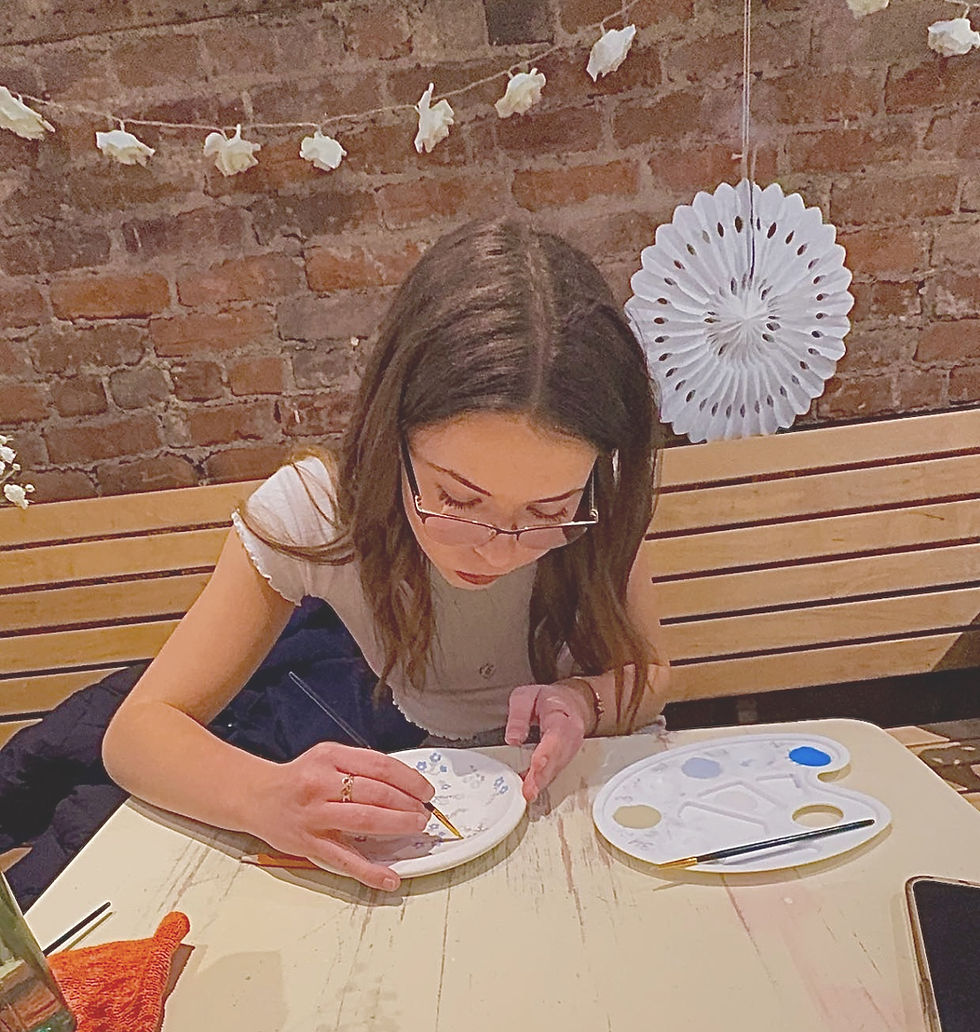I Thought I Had to Change—Until This Test Told Me Otherwise
- Olivia Tryburski
- Mar 9
- 8 min read
Updated: Mar 15

I’ve always been the one people count on. The friend who remembers birthdays, plans get-togethers, and checks in just to make sure everyone’s okay. In my family, I was the peacemaker—the one smoothing over arguments, making sure no one felt left out. At work, I took on extra tasks, not because I had to, but because I couldn’t stand the thought of letting someone down.
But at some point, I started wondering if I was doing too much. People told me I worried too much, that I was too focused on others, that I needed to “let things go” and stop trying to make everyone happy. I never understood how people could just move on so easily, how they could care one moment and be unaffected the next. I heard it so often that I started to believe it. Maybe I was too sensitive. Maybe I should be more independent, more spontaneous, more willing to say no.

So I tried to change. I held back when I wanted to help. I convinced myself to care less. But instead of feeling free, I felt trapped—like I was fighting against myself. When I tried fitting the mold of what people seemed to want from me, I didn’t feel like a better version of myself. I felt like someone else entirely.
And then I took the MBTI test.
Suddenly, it all made sense. My need to connect, to care, to create harmony. These weren’t weaknesses—they were strengths. I wasn’t broken, or “too much.” I was just a Consul (ESFJ). And for the first time, I saw myself clearly.
Maybe the problem wasn’t me. Maybe I just needed to understand myself better. And what’s more, I wasn’t alone. There were others like me—people who felt things just as deeply, who cared just as much, who struggled with the same thoughts. It made me feel seen, validated, like I belonged. Instead of trying to change myself, I could embrace who I was all along.
How Do We Define Personality?

Psychologists may not all agree on one exact definition of personality, but it's generally seen as the unique combination of thoughts, feelings, and behaviours that shape how we interact with the world. It’s influenced by a mix of genetics, life experiences, and the environment we grow up in. In simple terms, personality is what makes you, you.
Why We Love Personality Tests
There’s something comforting about seeing yourself reflected back in a way that makes sense. Personality tests do two things at once:

They make us feel unique—like there’s a special category just for us.
They make us feel connected—like we belong to a group of people who think and feel the same way we do.
That mix of individuality and community is addictive. It validates us and gives us a sense of certainty about who we are.
The Myers-Briggs Test: The Personality Test That Captivated Millions
If you’ve ever used a dating app or applied for a job, chances are you’ve come across the MBTI, or something inspired by it. It’s even used by the U.S military!
American writer Isabel Briggs Myers developed the test during World War II to help people understand themselves and collaborate more effectively in the workplace. Inspired by psychologist Carl Jung, she based it on his idea that behaviours are not random, but shaped by mental and emotional preferences.

The result? A system that describes people with just four letters (e.g, ENTJ or ISFP), each representing one of 16 possible personality types.
How Does It Work?
The MBTI is a self-report questionnaire that takes approximately 20-30 minutes to complete. Your answers to these questions determine where you fall on four preference dimensions. Your four-letter personality type describes how you get energized, process information, make decisions, and approach life. A popular free and online version of it is 16personalities.com.
Here are the 4 dimensions and a sample question that applies to each:
1. Introversion (I) or Extraversion (E)

2. Sensing (S) or Intuition (N)

3. Thinking (T) or Feeling (F)

4. Judging (J) or Perceiving (P)

Breaking Down the MBTI Dimensions
1. Where You Get Your Energy (E vs. I)

People who prefer Extraversion (E) find energy in social settings and external interactions. They enjoy lively discussions, seek new experiences, and often speak their thoughts aloud as a way to process ideas.
On the other hand, those who prefer Introversion (I) feel most energized in quiet, reflective environments. They enjoy one-on-one conversations, think before they speak, and focus deeply on their interests.
2. How You Take in Information (S vs. N)

Those who prefer Sensing (S) pay close attention to details, facts, and the present moment. They gravitate towards concrete information, enjoy hands-on experiences, rely on past experiences to inform their decisions, and trust what can be observed or measured.
In contrast, individuals who favor Intuition (N) focus on patterns, concepts, and future possibilities. They are drawn to abstract ideas, enjoy brainstorming, and often trust their gut feelings over concrete data.
3. How You Make Decisions (T vs. F)

People with a preference for Thinking (T) prioritize logic and consistency when making decisions. They analyze situations objectively, focusing on what makes the most rational sense.
In contrast, those with a preference for Feeling (F) prioritize emotions, relationships, and personal values when making decisions. They strive to create harmony, consider how decisions affect others, and are motivated by empathy and connection.
4. How You Approach Life (J vs. P)

Individuals who lean toward Judging (J) prefer structure, order, and clear plans. They enjoy making schedules, setting goals, and following a predictable routine.
Meanwhile, those who prefer Perceiving (P) embrace flexibility and spontaneity. They keep their options open, adjust plans as new information arises, and thrive in unstructured, dynamic environments.

The Truth, or a Scam?
While the MBTI can feel incredibly validating, it has its limitations. One of the biggest concerns is that it categorizes personality into four dimensions instead of five, unlike the Big Five Personality Traits, which are widely accepted in psychology. The Big Five model assesses personality on a spectrum rather than as categories. Instead of forcing people into either introversion or extraversion, for example, it recognizes that most of us exist somewhere in between.
The MBTI, in contrast, tends to describe people in more positive and palatable ways. While this makes it more appealing, it also means it may lack the predictive validity that scientific personality models provide.
But here’s the thing—I needed the MBTI to take that first step.
Seeing my type reflected back at me gave me a sense of clarity and belonging. It validated my experiences and helped me embrace my strengths. But as I delved deeper into psychology, I realized I wanted to understand myself in a way that was more grounded in research.
That’s when I took the Big Five Personality Test.
What the Big Five Revealed: A Deeper Look at Myself
Taking the Big Five Personality Test was a turning point in my journey. While the MBTI gave me a sense of validation and belonging, the Big Five pushed me to confront aspects of myself that weren’t as easy to digest—but were just as important to understand.

High Agreeableness: It made sense. I’ve always cared deeply about others, valued harmony, and gone out of my way to support the people in my life. But this also meant I struggled with setting boundaries and saying no. I realized that my desire to maintain relationships sometimes came at the cost of my own well-being.
Moderate-to-High Conscientiousness: I prided myself on being dependable and organized, but the test also revealed that my conscientiousness could warp into perfectionism—taking on too much, feeling responsible for things outside my control, and struggling to let go.
High Extraversion: I already knew I thrived on connection, but seeing it quantified helped me understand why alone time sometimes felt uncomfortable. I had to learn that taking space for myself wasn’t neglecting others—it was necessary for my emotional balance.
High Neuroticism: This was the hardest trait to confront. While I always knew I was an overthinker, seeing my high score in neuroticism made me realize just how much I internalized stress and worried about how others perceived me. Understanding this gave me the tools to work on emotional resilience and not let every worry dictate my self-worth.
Moderate Openness: I liked trying new things, but I also craved stability and structure. I wasn’t someone who thrived on constant change, and that was okay. Knowing this helped me lean into new experiences in a way that felt intentional, rather than forced.
This shift—from a popular personality test to a scientifically validated one—was part of my journey as a psychology student. Sometimes, we need something approachable to spark our interest before diving into the deeper, more complex science behind it. The MBTI may not be perfect, but for me, it was the first step toward a more nuanced and evidence-based understanding of myself.
Final Thoughts: Personality is Fluid, Not fixed
If you've taken the test and aren't fully satisfied with your personality type, it's important to remember that the MBTI doesn’t confine you to a box. Your environment, relationships and experiences are constantly changing and it's important to adapt to these changes. Holding on too tightly to your personality type hinders your ability to grow, so it's crucial to keep an open mind.

Think of your personality as a symphony—different preferences play louder at different times in your life. Just because I'm an ESFJ now, doesn't mean I can't be an INTP in the near future.
Overall, personality tests aren’t about proving who we are; they're about helping us understand ourselves and others a little better. Whether you believe in the MBTI or not, it offers a valuable starting point for self-reflection, encouraging us to explore the ways we think, feel, and interact with the world.

So informative! Thanks for sharing!
This post is very informative and helpful.
It gave me a new perspective on my personality, thanks for sharing
Learned about my own personality reading this blog, thank you for sharing!